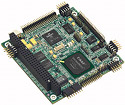PC/104 module runs Linux
Mar 10, 2009 — by Eric Brown — from the LinuxDevices Archive — 22 views ADlink has announced a PC/104 SBC (single board computer) based on DMP Electronics's x86-compatible Vortex86SX SoC (system-on-chip). The “CoreModule 430” includes 256MB of RAM, four serial ports, 10/100 Ethernet, two USB ports, and support for both CRT and TFT displays, the company says.
ADlink has announced a PC/104 SBC (single board computer) based on DMP Electronics's x86-compatible Vortex86SX SoC (system-on-chip). The “CoreModule 430” includes 256MB of RAM, four serial ports, 10/100 Ethernet, two USB ports, and support for both CRT and TFT displays, the company says.
(Click here for a larger view of Adlink's CoreModule 430)
ADlink, of course, acquired Ampro, originator of the PC/104 format, last year, and the CoreModule 430 is duly marketed under the “Ampro by ADlink” moniker. The new device is intended to replace PC/104 SBCs using Intel 80386 and 80486 CPUs, allowing “continued production of existing medical, industrial control, and avionics systems,” says ADlink.
While some SBCs these days are practically claimed to sing, dance, and tell after-dinner stories, ADlink refreshingly characterizes the CoreModule 430 as being appropriate for systems with “modest CPU performance requirements.” The device uses a Vortex86SX SoC (system-on-chip) from DMP Electronics, clocking it at either 300MHz or 800MHz, the company says.
 DMP Electronics's Vortex86SX (Click image for further information) |
The Vortex86SX (right), claimed by DMP to use only 0.9 Watts at 300MHz, packs numerous functions into a 27 x 27mm package, including a 32-bit, x86-compatible CPU, plus extensive northbridge and southbridge functions. On-chip controllers include serial, parallel, USB, GPIO (general purpose I/O lines), watchdog timer, counter, and a 10/100Mbps Ethernet controller, DMP says.
ADlink lists only Windows CE 5.0, Windows CE 5.0, and QNX as operating system choices for its CoreModule 430. Yet, previous Vortex86SX modules, such as Tri-M Engineering's VSX104 and SSV's DNP/2486 have added Linux and DOS to the roster, suggesting that the CoreModule 430 will be compatible with these OSes too.
The CoreModule 430 is limited to 256MB of soldered-on DDR2 memory, according to ADlink. Like other classic PC/104 modules, the device has a 3.8 x 3.6 inch (96 x 90mm) form factor, offering 16-bit ISA bus signals to the outside world via a stackable connector. And, also like others, the CoreModule 430 supplements its PC/104 connector with a multitude of pin headers spread around the edge of the board.
ADlink didn't specify which interfaces are served up by the CoreModule 430's pin headers, but overall, the module is said to offer 10/100 Ethernet, two USB 2.0 ports, four serial ports (two RS232, two RS232/422/485), EIDE, a parallel/floppy interface, eight GPIOs, and PS/2 keyboard/mouse support. Equipped with a CompactFlash socket for onboard storage, the module supports both TFT and CRT displays, the company adds.
Features and specifications listed by ADlink for the CoreModule 430 include the following:
- Processor — DMP Electronics Vortex86SX clocked at 800MHz or 300MHz
- Memory — 256MB of soldered-on DDR2 RAM
- Storage — Includes CompactFlash slot
- Displays — Supports TFT and CRT displays
- Networking — 10/100 Ethernet
- Other I/O:
- 4 x serial (2 x RS232, 2 x RS232/422/485)
- EIDE (DMA 100)
- Bidirectional ECP/EPP parallel port, with support for 1 or 2 floppy disk drives
- PS/2 interface for keyboard/mouse
- 2 x USB 2.0
- 8 x GPIO
- 4 x serial (2 x RS232, 2 x RS232/422/485)
- Expansion — CompactFlash slot
- Operating temperature:
- Standard version — -20 to 70 deg. C (-4 to 158 deg. F)
- Extended version — -40 to 85 deg. C (-40 to 185 deg. F)
- Standard version — -20 to 70 deg. C (-4 to 158 deg. F)
- Dimensions — 3.8 x 3.6 inches (96 x 90mm)
Availability
ADlink did not release pricing or availability information for the CoreModule 430. However, more information on the SBC can be found on the company's website, here.
This article was originally published on LinuxDevices.com and has been donated to the open source community by QuinStreet Inc. Please visit LinuxToday.com for up-to-date news and articles about Linux and open source.